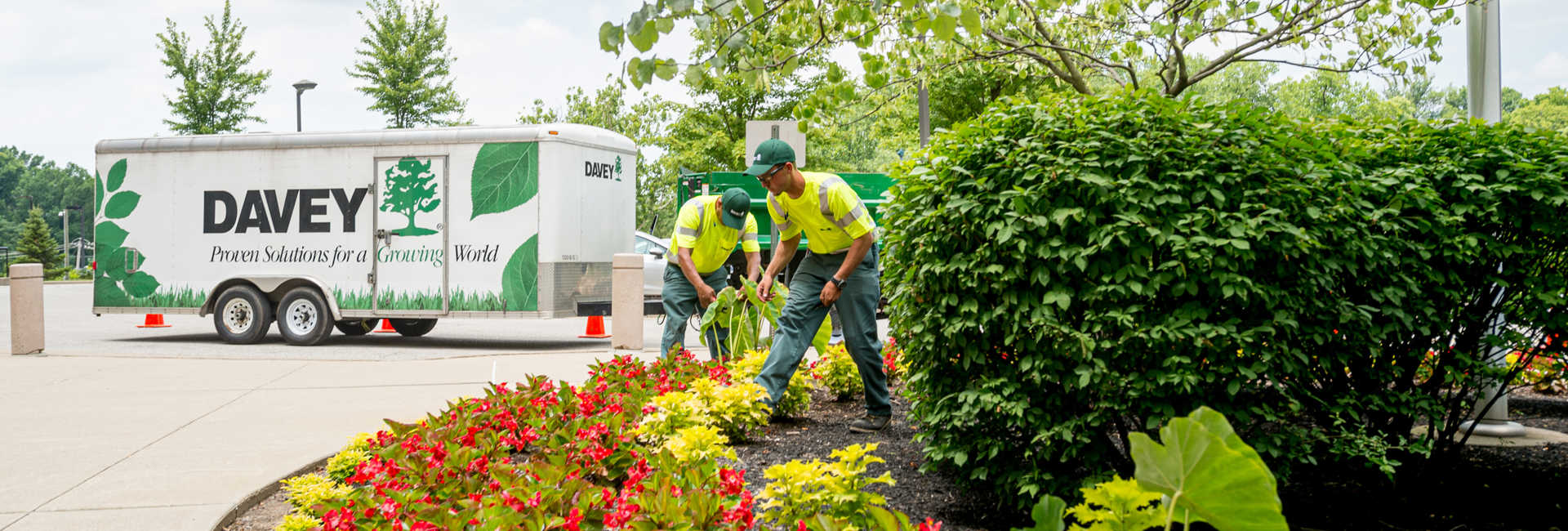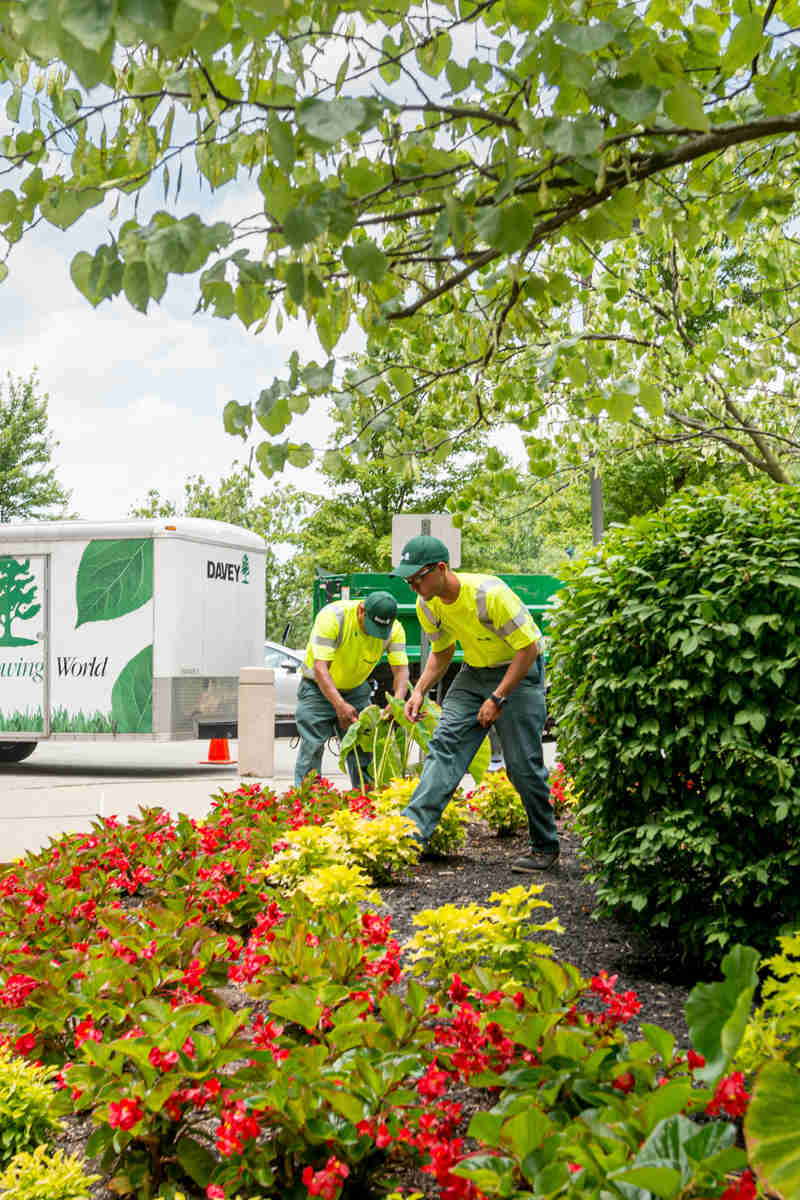Your trees provide some major benefits to your commercial property.
They bring shade, so your visitors and guests have a place to escape the heat of the sun. They can even help cool your building in the summer months, reducing your air conditioning bills. They also offer beauty and majesty, giving your facility character and interest. This means whether you manage a retail center, an office park, a healthcare facility, an industrial property, a school or college, or anything in between, your perception and outdoor brand needs to remain strong and professional.
But trees, just like other living things, can be susceptible to insect infestations. Keeping your trees healthy ensures they keep delivering these benefits and don’t succumb to pest threats.
Let’s look at the most common insects that harm trees on commercial properties based on your specific region so you can better identify their symptoms and catch any problems in advance when they are easier to control.
You can also watch the video above for a quick overview of common symptoms from emerging spring pests and what can be done to help prevent them.
Common Spring Tree Pests in the West & Southwest: Signs & Symptoms
Common tree pests in the West and Southwest usually exploit weak trees.
Recognizing visual signs can give you a head’s up as to what is going on with your tree, and spotting these symptoms early can make a world of difference in preventing detrimental damage.
White Cottony Tufts on Conifer Needles and Bark
If you have small, newly transplanted, or stressed-out trees, they may be more susceptible to some pests. But a lot of factors are based on weather and predator activity.
Take a look at your conifers (e.g. firs, pines, and hemlocks). If you notice small, cottony tufts on the bark or needles,, one of the following insects may be present:
- Cooley spruce gall adelgid on Douglas fir - The white waxy fringe these pests cause is from nymphs that overwintered on needles. Once spring arrives, they begin to feed and produce these waxy threads to lay eggs within – up to 100 at a time.
- Hemlock woolly adelgid on hemlocks - These insects will create tiny white tufts at the base of hemlock needles that look like bits of wool that also act as egg sacs.
- Balsam woolly adelgid on firs - While this insect adult is hardly noticeable to the naked eye, its woolly mass covers adults and their eggs, making infestations more visible. Look for white dots along the trunks, limbs, and buds of infested trees.
- Pine bark adelgid on white pines - If this pest is present, the branches and trunks of your white pines will have white, woolly masses on them, sometimes leading to weakened trees.
Honeydew on Leaves and Dripping on Ground
If you notice a clear, sticky substance on your plants or on the items beneath your tree, such as outdoor furniture that may be part of an office park space, this is likely “honeydew” secretion.
If the sticky substance is accompanied by a black sooty coating on the leaves, then a sooty mold is also developing. Ignoring these issues can result in leaf drop and the continued spread of the infestation.
You likely have one of two types of insects that harm trees:
- Aphids - These tiny, soft-bodied insects suck fluid from your trees and secrete the sticky honeydew. If enough aphids are feeding on your tree, honeydew will drip. Aphids can spread tree pathogens.
- Soft scales - These insects are small, oval, and flat with a protective shell-like covering. Depending on the species, they can be found on leaves or bark. As they suck the fluid from your tree, they secrete honeydew, which encourages sooty mold growth. As soft scales feed on your tree, they can begin to turn leaves yellow and then leaf drop can result.
Pitching and Holes on Bark, Galleries Under Bark
Seeing small holes in your tree and wondering, “What bug is killing my tree?”
Holes in your tree bark or damage under the bark are usually a sign of some sort of boring insect-like one of these:
- Bark beetles- Bark beetles tunnel below tree bark forming galleries. They are usually small and reddish-brown to black. Some bark beetle species can spread pathogens from tree to tree.
- Flathead borers - Flatheaded borers are beetles that attack stressed, dying, or dead trees. Adults tend to be torpedo-shaped with a metallic coloring. The tunnels they make in trees are packed with frass: insect poop.
- Roundheaded borers - Roundheaded borers are beetles that usually have antennae that are longer than their bodies. They can grow to 2 inches in length, longer than flatheaded borers. They also attack stressed trees and their tunnels also contain frass.
- Clearwing moths - Clearwing moth larvae bore beneath tree bark and push frass from their tunnels. Small piles or a scattered dusting of frass can mark the location of tunnel openings. You can sometimes see clearwing pupal cases protruding from the bark.
Feeding Holes or Skeletonized Leaves of Evergreen Shrubs
Skeletonized plant leaves are never great to find on your commercial property.
This type of defoliation refers to the insect consuming the soft leaf material and neglecting the hard veins. Creating leaf “skeletons” results in a reduction of overall plant vitality.
Two common leaf skeletonizers in the West and Southwest are:
- Viburnum leaf beetle - This pest can be found dining on viburnum leaves in late spring and summer. Both adults and larvae feed on plant leaves. Between 4.5 and 6.5 millimeters long, adult beetles have gold-gray bodies and brown heads.
- Root weevils - The adult insects chew notches along the edges of leaves, but the worst damage is due to the larvae. They feed and develop on plant roots. These are considered one of the worst pests that attack rhododendrons.
Common Spring Tree Pests in the Midwest: Signs & Symptoms
In the Midwest, there are two common symptoms you’ll see most often on your commercial facility’s trees, which can help you properly identify the insects that are harming your trees.
Sticky Droplets of Honeydew, Curled Leaves, and Yellowing
Soft-bodied, pear-shaped aphids that range in size from a pinhead to ¼ inch in length are most likely to blame if you’re seeing leaf curling.
Aphids feed on the sap of many tree species with their piercing and sucking mouthparts. They exude honeydew as they feed. This feeding can also lead to curling and discolored leaves.
Leaking Sap From the Trunk, Frass, and Pupal Cases Emerging From the Trunk
If you’re seeing leaking sap, frass orbits of sawdust coming out of tree holes, or even pupal cases left behind, it’s likely the result of clearwing borer larvae, which feed on the sapwood of trees during the summer.
Clearwing borers are attracted to quite a few species of stressed, young trees where they lay their eggs, especially understory trees planted in full-sun.. Susceptible trees include alder, ash, birch, dogwood, lilac, hawthorn, mountain ash, maple, oak, poplar, sycamore, viburnum, and willow. Help protect newly planted trees by providing proper irrigation, especially in the first year.
Adult clearwing borers are actually moths that have a wasp-like appearance.
Common Spring Tree Pests in the Northeast: Signs & Symptoms
The Northeast is home to quite a few insects that can harm trees.
Read through each symptom and it will help you narrow down your potential pest problem.
Webs Appear on Branch Tips
Notice the tips of your trees’ branches covered in “webs” or silk structures on your commercial property? It’s likely caused by the fall webworm.
In winter, these pests lay eggs, which hatch in spring. During summer, the caterpillars eat your tree leaves and begin creating their silk shelters in time for autumn.
For mature trees, these pests’ webs are normally just eyesores, but feeding on young trees can cause leaf loss. Though fall webworms see a wide variety of trees as potential food, you’ll likely see webs in walnut, elms, and some maples.
Frass Tubes and Bleeding Sap Appear From Small Holes in the Bark of Stressed Trees Early in the Growing Season, Foliage Above Wilting
Are you seeing foliage above a certain point in some of your trees wilting?
This could be the result of ambrosia beetles, which bore into the trees. These beetles generally attack the tree within 3 feet from the ground. You may see sap oozing from the holes they cause, which can stain the bark.
These insects that harm trees dine on the symbiotic ambrosia fungus they cultivate as they form galleries throughout your tree’s inner bark. This can cause the tree to decline because it can no longer take in water and nutrients through its blocked xylem vessels.
Ambrosia beetles have a wide host range of trees and shrubs, including ornamental cherry, Japanese maple, holly, dogwood, sweetgum, magnolia, ash, beech, birch, elm, linden, oak, planetree, tulip tree, willow, and azalea.
Large Amounts of Honeydew and Sooty Mold Accumulate Below Trees Then Mud-like Egg Masses Overwintering on Vertical Surfaces Late in the Growing Season
Weeping or oozing sap from trees on your commercial property in the Northeast can be the result of the spotted lanternfly.
This invasive species is a serious pest, known for causing damage to a wide variety of hosts, including oak, maple, and willow trees.
They aggregate in large clusters on your trees, causing a build-up of sticky honeydew and sooty mold. You might also see their egg masses, which are covered with a whitish-brown mass. As the spotted lanternflies feed on your trees, you may also notice leaf wilting and curling.
Common Spring Tree Pests in the Southeast: Signs & Symptoms
When it comes to insects that harm trees on your Southeast commercial property, you’re usually looking for two major symptoms that can help narrow down your tree infestation identification possibilities.
Curling, Stunted, Yellowing Leaves with Dark Sticky Film on Leaves and Stems
When it comes to sticky leaves and trees with yellowing leaves in spring, look no further than the aphid.
In the Southeast, crape myrtles are most susceptible.
Aphids are soft-bodied, sap-feeding insects that range in color from pink and yellow to pale green or even black. They vary from 1/16th of an inch to ⅛ of an inch long. They often overwinter as eggs that hatch in spring. These aphids eat by inserting their mouthparts into tender new leaves to suck sap. They excrete large amounts of sugary liquid called honeydew, which can coat leaves. This can also encourage the growth of sooty mold fungi, which causes a black substance to coat leaves.
Dieback, Browning, and Death of Entire Limbs, Foliage, and Tree
Meet the most destructive insects that harm trees, particularly pines, in the southeastern U.S.: the southern pine beetle.
This native pest lives in the inner bark of pine trees, feeding on phloem tissue where they construct winding, S-shaped galleries. These numerous galleries the adult beetles and their offspring cause can eventually girdle and kill a tree.
The most susceptible species in the Southeast include loblolly pines, slash pines, and shortleaf pines.



